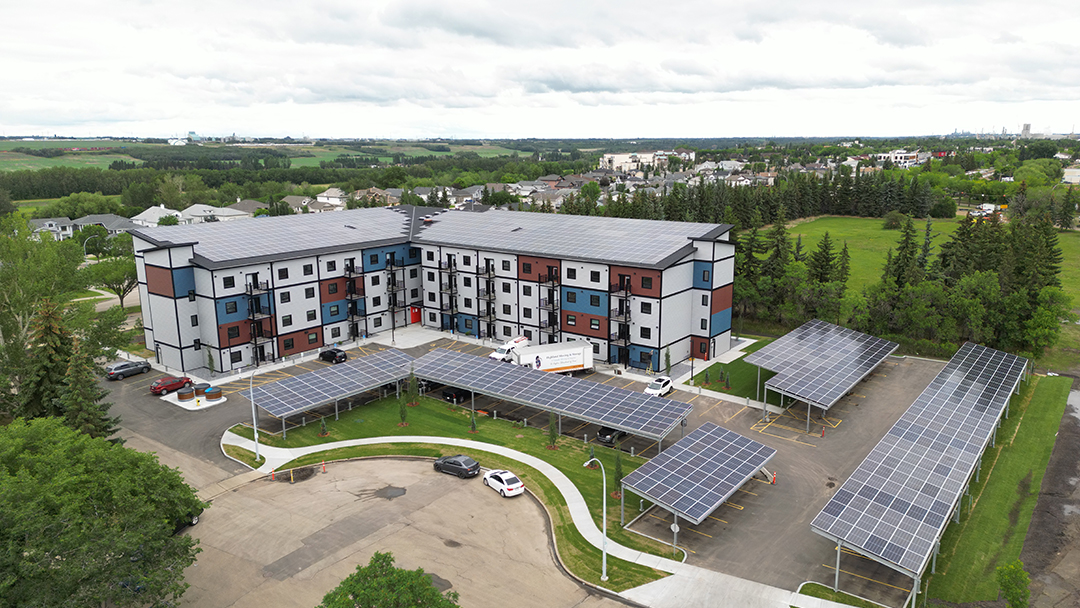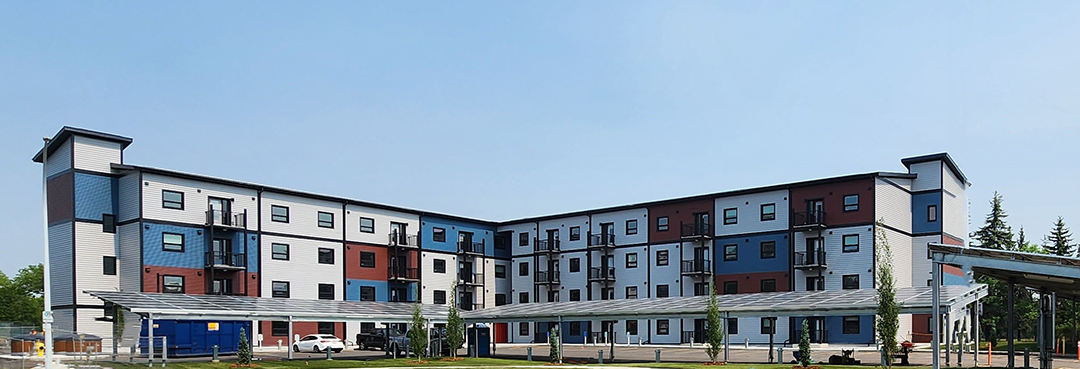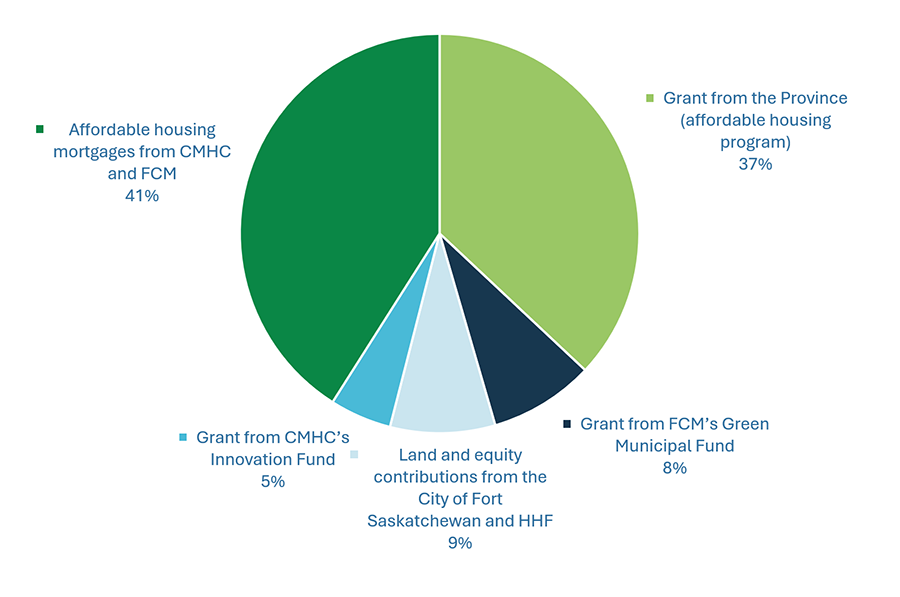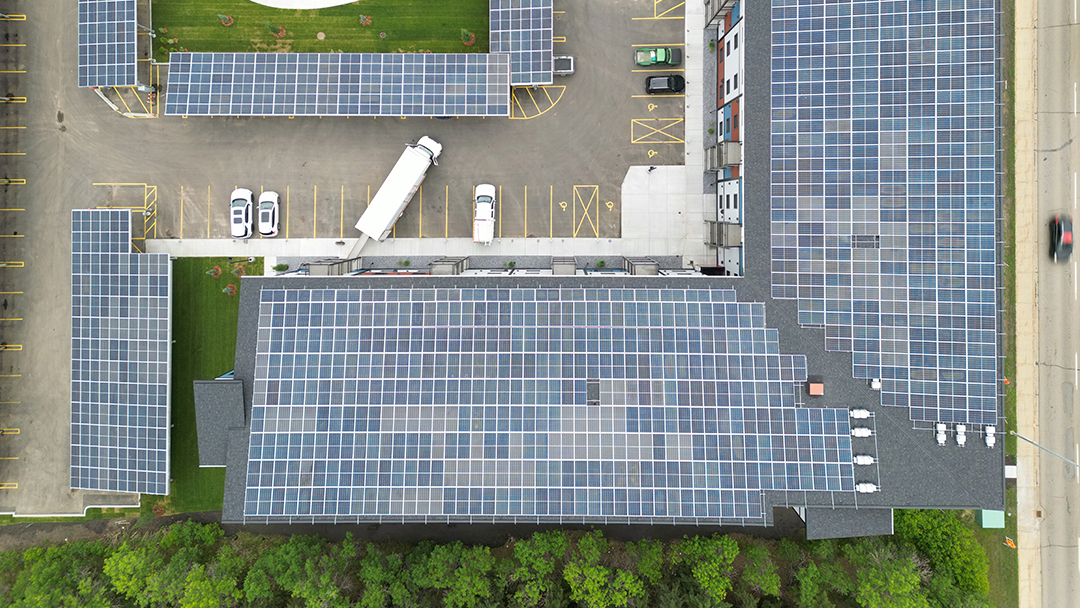Fort Saskatchewan, Alberta, has just welcomed a transformative new addition to its housing landscape: the city’s first purpose-built, all-ages affordable housing complex,the Muriel Ross Abdurahman Court. This development is part of a series of initiatives long-term affordability. It also stands out as a pioneering net zero project.
At the helm of this project is the Heartland Housing Foundation (HHF), led by executive director Nancy Simmonds, who brings over 15 years of experience in affordable housing. Since assuming leadership in 2019, she has guided the organization through a period of sustained growth, expanding its portfolio by nearly 50 per cent with the addition of 250 new units and 200 rental subsidies. Growth is a central part of Simmonds’s strategy, supported by a commitment to innovation, a willingness to seize new opportunities, and, in this project, a focus on diversifying revenue sources to maintain that momentum.
In Fort Saskatchewan, HHF is not only increasing housing supply but also strengthening its long-term sustainability by diversifying revenues and investing in energy-efficient infrastructure.
“Solar doesn’t directly affect tenants’ utility bills, as we oversee and standardize those costs,” explains Simmonds. “But it significantly reduces our long-term operating expenses. We estimate a 45% reduction in utility costs compared to a traditional system.”
Innovation fueled by necessity
The project had unconventional beginnings. Originally envisioned in 2015 as a modular building made entirely from shipping containers, the plan had to pivot due to rising costs and a global shortage of containers. The final design preserves the innovative spirit, using containers on the main floor and a traditional wood frame structure above, while shifting the focus to high-efficiency systems and solar generation.
These adjustments proved critical in securing a blend of funding, including grants from the CMHC Affodable Housing Innovation Fund and FCM’s Green Municipal Fund, both of which prioritize energy-efficient and replicable housing models. About 40% of the total cost was covered by a provincial grant, with additional contributions from CMHC, the City of Fort Saskatchewan, and municipal financing tools.
Incorporating solar energy into the project wasn’t easy. Alberta’s energy infrastructure isn’t currently optimized for distributed generation, and selling power back to the grid required navigating complex compliance regulations. Despite delays, HHF now successfully feeds electricity back into the system.
“For future projects, we’re exploring how to use all solar energy onsite to avoid similar issues,” says Simmonds.
HHF’s approach reflects an emerging strategy in the sector: using self-generated energy to diversify revenues and stabilize operating costs. In a context where operating margins are slim and traditional funding is often uncertain, being able to reduce or offset energy costs opens a powerful path to sustainability.

Net-zero as a strategic choice
While solar panels often receive the spotlight, Simmonds is quick to point out that achieving net-zero involved a suite of design choices: upgrading the building envelope, replacing gas systems with electric mechanical ones, and careful long-term planning for capital reserves.
“The main upfront cost was the solar panel system, which we covered through the Green Municipal Fund,” she notes. “Over the medium to long term, the systems we’ve chosen have comparable maintenance costs to traditional ones.”
This net-zero project isn’t just environmentally responsible, it’s financially savvy. By significantly lowering utility expenses, HHF can protect affordability over the long term without depending on continuous external funding.
And while tenants don’t directly benefit from reduced bills, the model creates organizational stability, allowing HHF to reinvest in operations, maintenance, and future projects. That kind of financial foresight is central to the foundation’s vision.
“Our strength lies in creating housing that’s operationally sustainable and rooted in community context,” says Simmonds. “We aim to create inclusive, equitable buildings that reflect community needs.”

Turning innovation into a replicable model
For organizations considering a similar path, Simmonds offers clear advice: engage experienced net-zero developers early, involve your utility distributor from the start, and stay flexible.
“It’s never a straight path, but it’s worth it,” she says. “Learn from others, build flexibility into your design, and be prepared to adjust course to meet funding requirements.”
HHF is already applying the lessons learned in Fort Saskatchewan to its next development: a 104-unit complex in Sherwood Park that will include a not-for-profit daycare and additional accessible housing in partnership with the Robin Hood Association. These kinds of integrated services are key to HHF’s approach: housing that’s not only affordable and sustainable but also responsive to local needs.
“We started as a seniors housing provider but have grown into a provider for the entire community,” explains Simmonds. “We aim to build for inclusion, whether that means accessible units, support for people with disabilities, or family-friendly amenities like childcare.”
Building for the long term
In Alberta, where housing starts are booming but deeply affordable units remain scarce, HHF’s work is more critical than ever. Their ability to pair financial ingenuity with environmental responsibility offers a replicable model for other communities facing similar pressures.
This is the promise of net-zero affordable housing: not just energy savings or emissions reductions, but a structurally sound and financially resilient future for community housing providers.
And as Heartland Housing Foundation has shown, it’s a future that’s already being built, one solar panel at a time.
Financing Snapshot – HHF Project
HHF’s $17M affordable housing project was made possible through a creative blend of funding sources:

Notably, HHF secured two separate mortgages: CMHC in first position and FCM in second, alongside a $1.4M grant from FCM. While FCM’s loan terms were similar to CMHC’s, they carried a slightly higher interest rate.
Supporting innovation through the Center’s REC program
This blend of innovation, resilience, and replicability is exactly what the Centre’s Regional Energy Coach (REC) program is designed to support. The REC program helps housing providers across Canada plan and implement energy-efficient retrofits and new builds, offering technical guidance and strategic advice to reduce emissions and operating costs.
We’ve asked our Regional Energy Coach Majed Hargaaya about what the biggest myth about net-zero affordable housing is:
“One of the biggest myths is that net zero is too expensive, impractical and complex for affordable housing providers. In reality, with the right combination of design and incentives, it can be cost neutral or even cost saving over time. Another common misconception is that net zero is only possible in new construction. In fact, retrofits can also approach net zero with the right strategy. There’s also a belief that it compromises comfort, but when done properly, these buildings are healthier, quieter and more resilient to climate events and energy price fluctuations.”

Incentives for net zero projects
Non-profit housing providers often overlook valuable tools that can reduce capital costs and boost project viability.
Other options to explore
National programs:
- Canada Greener Affordable Housing (CGAH) – Forgivable loans and grants for deep retrofits and new builds.
- Indigenous Clean Energy programs
Regional/municipal programs:
▪️ Regional Energy Coach (free service)
▪️ Municipal climate funds (e.g. Edmonton’s CEIP)
▪️ On-bill financing (where available)







